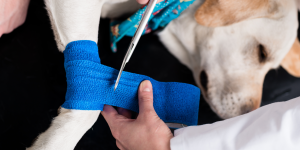Broken Bones in Dogs.
It can be frightening for dog owners if their pet receives an injury involving a broken bone. However, Holidays4Dogs offers some information on what to expect if your dog breaks a bone and how you can help him recover.
Broken bones in dogs are commonly associated with;-
-
falling from a height,
-
being accidentally stepped on, (toy dogs in particular)
-
road traffic accidents.
Sometimes broken and fractured bones are obvious, especially if the bone in question is protruding through the skin.
Broken bones in dogs may also be suspected if the bone in question is visibly angled under the skin. This is more evident in breaks involving the legs.
However, even where there appears to be no visible evidence of a broken bone, your dog will be in a lot of pain if a fracture, or break has occurred.
Here are some symptoms to look out for, where there is no visible indication of a broken bone;-
Symptoms where there is no visible evidence of broken bones.
-
In limb breaks, the dog may carry the leg awkwardly, or the dog may limp.
-
Whining/crying.
-
Panting.
-
These symptoms may indicate indicate your dog has suffered a serious injury. The dog will require urgent veterinary attention.
Moving a dog with suspected broken bones.
If you suspect your dog has broken a bone, it is essential to seek immediate veterinary attention. Pain killers will help avoid any further damage, or infection – but these must be administered to your dog by your vet. If there are any open wounds, cover these with a clean bandage, or any available clean material.
It may be an idea to use something solid to carry your dog – perhaps the base of a crate – or, if nothing else, a blanket. Try and support broken limbs with rolled up towels. An injured dog may be more likely to bite, so it is best to remain calm and reassure the dog as much as possible.
Treatment for broken bones in dogs.
Treatment, depends on the nature of the broken bone and where it is located. Multiple fractures, breaks involving joints and compound fractures, (where the break exposes an area of bone), may involve more serious complications from infection and blood loss.
In addition to this, multiple breaks may be more complicated to re-set. Surgery is common when it comes to the treatment of fractured and broken bones.
Broken bones above the knee-joint are held commonly secure with metal pins. For breaks occurring below the knee, an external cast is applied to re-set the damaged bones.
After surgery, the healing process can take around 4-8 weeks, (depending on the injury and the condition of the dog). This means the dog must not walk, run, jump, or play and must have plenty of rest.
Physiotherapy can improve the condition of the limbs. This is particularly important for dogs requiring extended cage rest.
Conclusion.
The prognosis for broken bones, even complicated fractures, is usually very good. Once the dog has regained his, or her, strength, it is best to gradually build up daily exercise again. Once fully recovered, dogs can normally go back to leading a perfectly healthy and active life.



